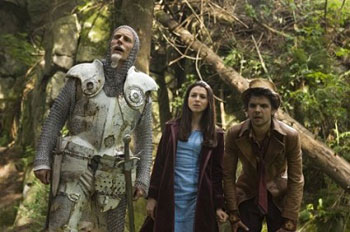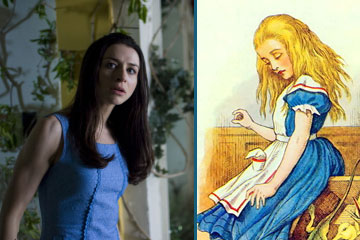So in Carroll's tales, Alice thumbs her nose at childhood
by telling fractured versions of nursery rhymes. In addition, she learns
to evaluate social convention, rather than simply following whatever
those around her do. Most importantly, she learns to say no to questionable
authority figures and discovers her own inner compass of right and wrong.
Though I think such theories of childhood development
were far from being expressed by the scientific world, Carroll seemed
to understand the transformation between young children doing what they're
told JUST because they are told to do so, and older children developing
their own internal sense of right and wrong.
In the SyFy adaptation, Alice makes peace with her childhood
issues of abandonment, spurred by her father's disappearance. She learns,
as well, that some men can be trusted, even if others might be questionable.
Most importantly, she finds the power within herself to make choices
that affect her own fate and the fate of those around her.
SyFy's Alice is frozen in childhood, wearing a childlike
smock reminiscent of the blue dress worn in the colored versions of
the famous John Tenniel illustrations. While Carroll's Alice is eager
to grow up and wishes to challenge the adult world she finds bewildering,
SyFy's Alice chooses instead to remain in a childlike state of denial.
The adaptation does a great job of capturing the dreamlike
feel of Wonderland, although envisioned differently. While Carroll's
Alice travels through a world reminiscent of the park (and, presumably,
nearby cultured gardens) where she falls asleep, SyFy's Alice wanders
through an urban landscape reminiscent of the city where she and her
mother live.
Spatial disorientation figures in both. Whereas Carroll's
Alice wrestles with feeling sometimes too small and sometimes too big,
almost everywhere SyFy's Alice travels, she finds herself on the edge
of tall cliffs or drop-offs. In Carroll's stories, Alice is struggling
to deal with the twin desires of wanting to grow up and wanting to retain
childhood pleasures. In SyFy's version, Alice views the world around
her as threatening and feels incapable of dealing with its challenges.
Both worlds follow dream logic, with spaces transforming
and characters mutating (such as, in Carroll's version, the baby that
turns into a pig). In SyFy's version, Alice enters rooms and finds both
the rooms and the surrounding scenery alters. Characters remain somewhat
more stable, although they often undergo costume changes that indicate
new aspects of their personalities.
Carroll's Alice encounters a number of flawed mother figures,
such as the Duchess, who abuses her baby/pig, or in Through the Looking
Class, the Red Queen, who lectures Alice endlessly. In SyFy's version,
Kathy Bates is a bit of a scenery-chewer as the Queen of Hearts, but
to be fair, the character is portrayed that way in the book as yet another
scolding, flawed mother figure. More importantly, Alice meets several
ineffectual father figures, as well as a grandfather figure in the White
Knight, played to perfection by Matt Frewer, with a daft but benign
sense of grandeur that would make Don Quixote proud.
In most adaptations of Carroll's tales, the Mad Hatter
is presented as a flawed authority figure, against whom Alice eventually
rebels, refusing to participate in his mad tea party. In SyFy's version,
the Hatter is a good-looking young man (Andrew Lee Potts). But just
like, in Carroll's tale, the Mad Hatter helps Alice learn to assert
herself, SyFy's Hatter helps Alice deal with her issues of trust.
At first glance, he seems like exactly the sort of person
the cautious Alice would avoid on the dating scene. Though good looking,
he is flighty and seems a risky choice. By contrast, her boyfriend,
Jack, whose abduction from her world led to her finding the looking
glass, seems a very upright, trustworthy guy. As she journeys through
this world she learns more about each of them and learns, as well, to
trust her instincts.
I like the way this version incorporated some often-overlooked
stories, such as the Carpenter's tale of the oysters, who run a race
without realizing they are running towards their own demise. In SyFy's
version, the people from the real world are referred to as oysters,
kidnapped and brought to Wonderland for the queen's uses.
In many ways, the SyFy adaptation does to Carroll's books
what the original Alice did to nursery rhymes: often half-remembered
and out of place and yet, familiar. Much like the way an adult Alice
might remember the classic children's books.
Overall, I was impressed with this adaptation.
Rating: **** (4 out of 5 stars)



